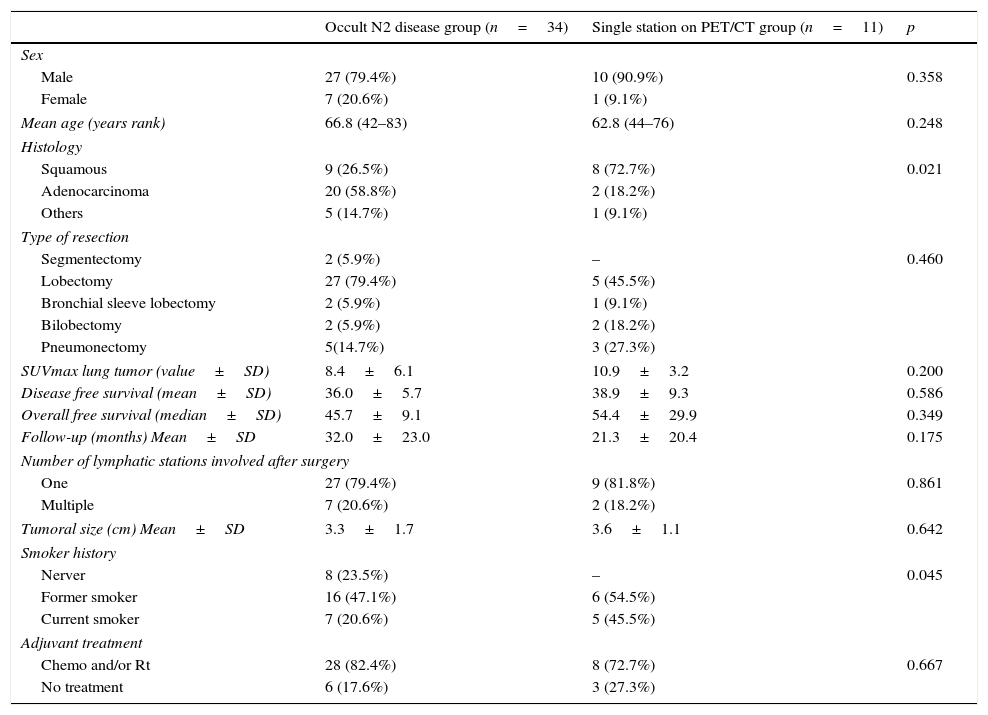A retrospective study, using a prospective database, was conducted on patients treated with surgery in order to analyze the prognosis between two groups: NSCLC (non-small cell lung cancer) patients with occult N2 disease and patients with single station N2 disease observed on pre-operative integrated PET/CT scan.
MethodsA total of 772 patients underwent surgical treatment for lung cancer from January 2007 to December 2014. All of them had an integrated PET/CT scan in the pre-operative work-up and a pulmonary resection plus mediastinal lymphadenectomy were performed in all cases. In the selected cases, no one received induction treatment. All patients from both groups had N2 disease after examination of the histopathology specimen. Clinical and pathological characteristics, disease free survival, and overall survival, were analyzed in both groups.
ResultsA total of 34 cases presented occult N2 disease, whereas 11 cases showed single station N2 disease on pre-operative PET/CT scan. Mean disease free survival and mean overall survival for occult N2 disease compared to single-station N2 disease on PET/CT scan was 36.0 months (95% CI: 24.9–47.1) and 38.9 months (95% CI: 20.6–57.1), p=.586; and 52.3 months (95% CI: 38.9–65.7) and 38.2 months (95% CI: 21.9–54.5), p=.349, respectively.
ConclusionThe prognosis of patients with single-station N2 disease on PET/CT scan treated by surgical resection and mediastinal lymphadenectomy as first line treatment was similar to those with occult N2 disease. More studies are needed to support our findings.
Estudio retrospectivo de una base de datos prospectiva sobre pacientes tratados con cirugía para analizar el pronóstico entre dos grupos: pacientes con cáncer de pulmón no células pequeñas con enfermedad N2 oculta y pacientes con enfermedad N2 estación única observados en el estudio preoperatorio con PET/TC integrado.
MétodosDesde enero de 2007 hasta diciembre de 2014 un total de 772 pacientes fueron operados por cáncer de pulmón. Todos los pacientes tuvieron una PET/TC en el estudio preoperatorio y se les realizó la resección pulmonar más linfadenectomía mediastínica. En los casos seleccionados no hubo tratamiento de inducción. Todos los pacientes de ambos grupos fueron N2 después del examen anatomopatológico. Se analizaron las características clinicopatológicas, la supervivencia libre de enfermedad y la supervivencia global de ambos grupos.
ResultadosUn total de 34 casos fueron enfermedad N2 oculta, mientras que 11 casos mostraron enfermedad N2 con estación única en el estudio preoperatorio con PET/TC. La supervivencia libre de enfermedad y la supervivencia media global para la enfermedad N2 oculta comparada con la enfermedad N2 con estación ganglionar mediastínica única fue de 36,0 meses (IC 95%: 24,9-47,1) y 38,9 meses (IC 95%: 20,6-57,1) p=0,586 y de 52,3 meses (IC 95%: 38,9-65,7) y 38,2 meses (IC 95%: 21,9-54,5) p=0,349, respectivamente.
ConclusiónEl pronóstico de los pacientes con enfermedad N2 de estación única en PET/TC tratados con cirugía y linfadenectomía mediastínica como primera línea de tratamiento fue similar a aquellos con enfermedad N2 oculta. Más estudios son necesarios para apoyar nuestros resultados.
Article

Revista Española de Medicina Nuclear e Imagen Molecular (English Edition)










